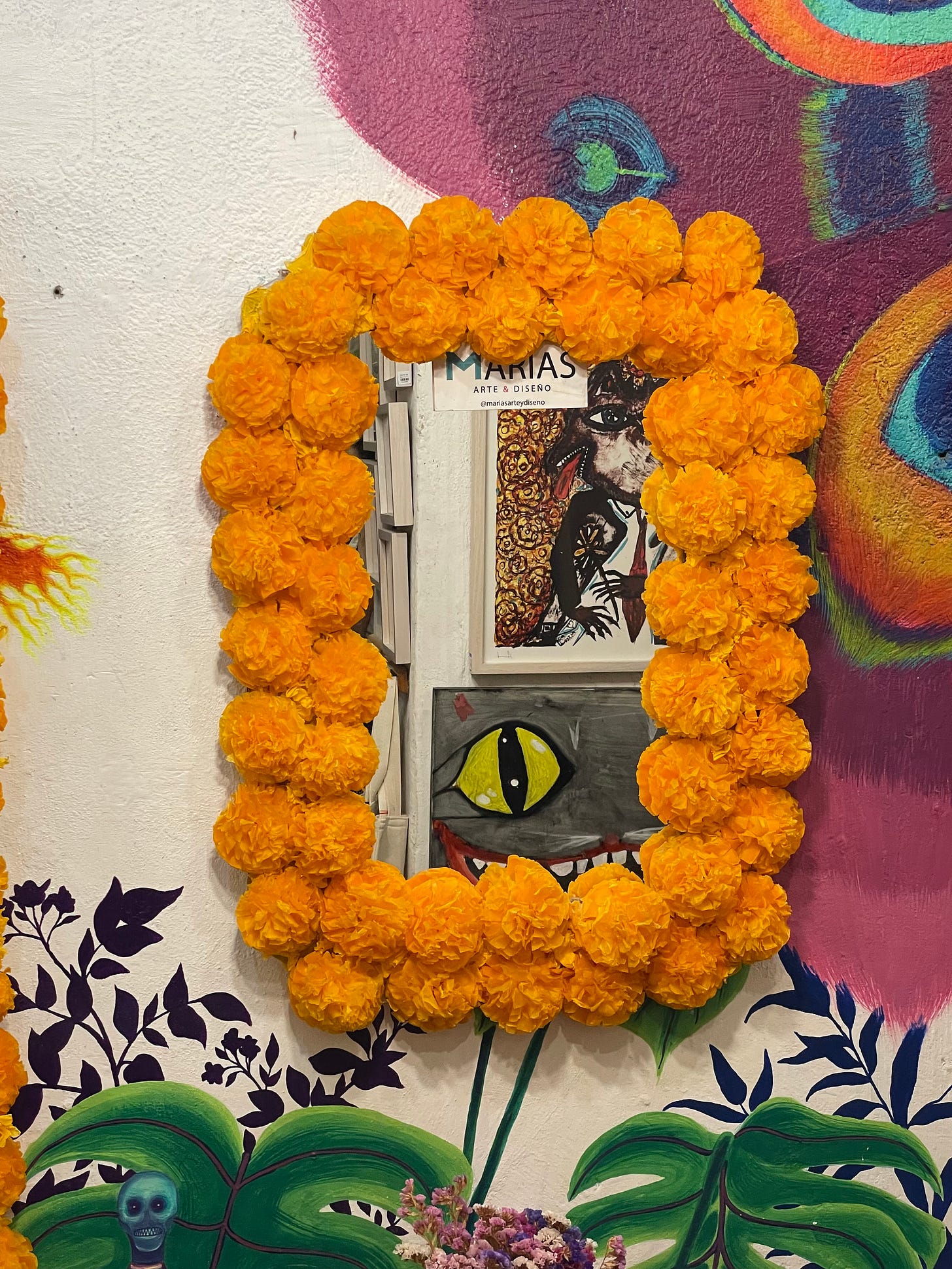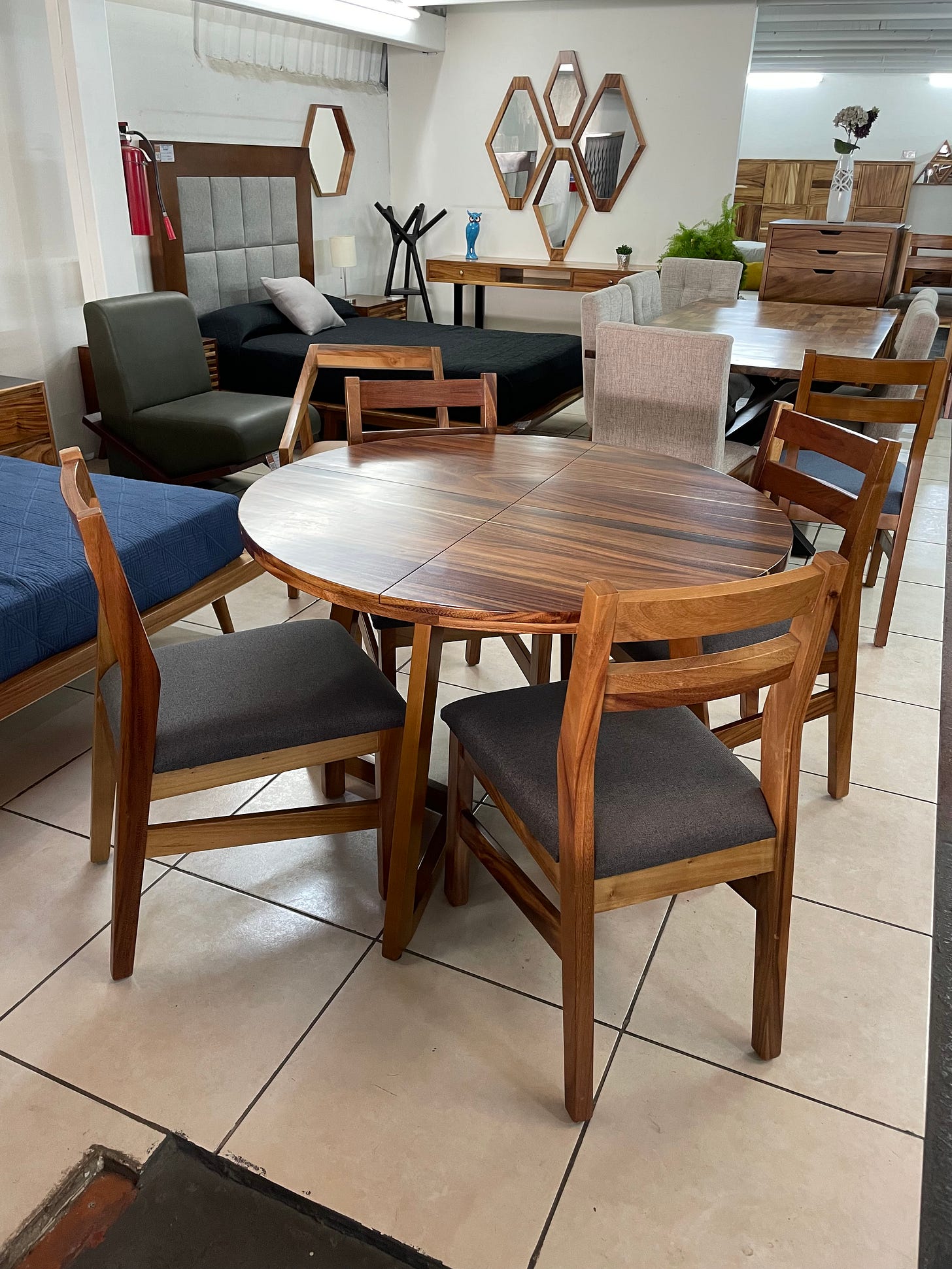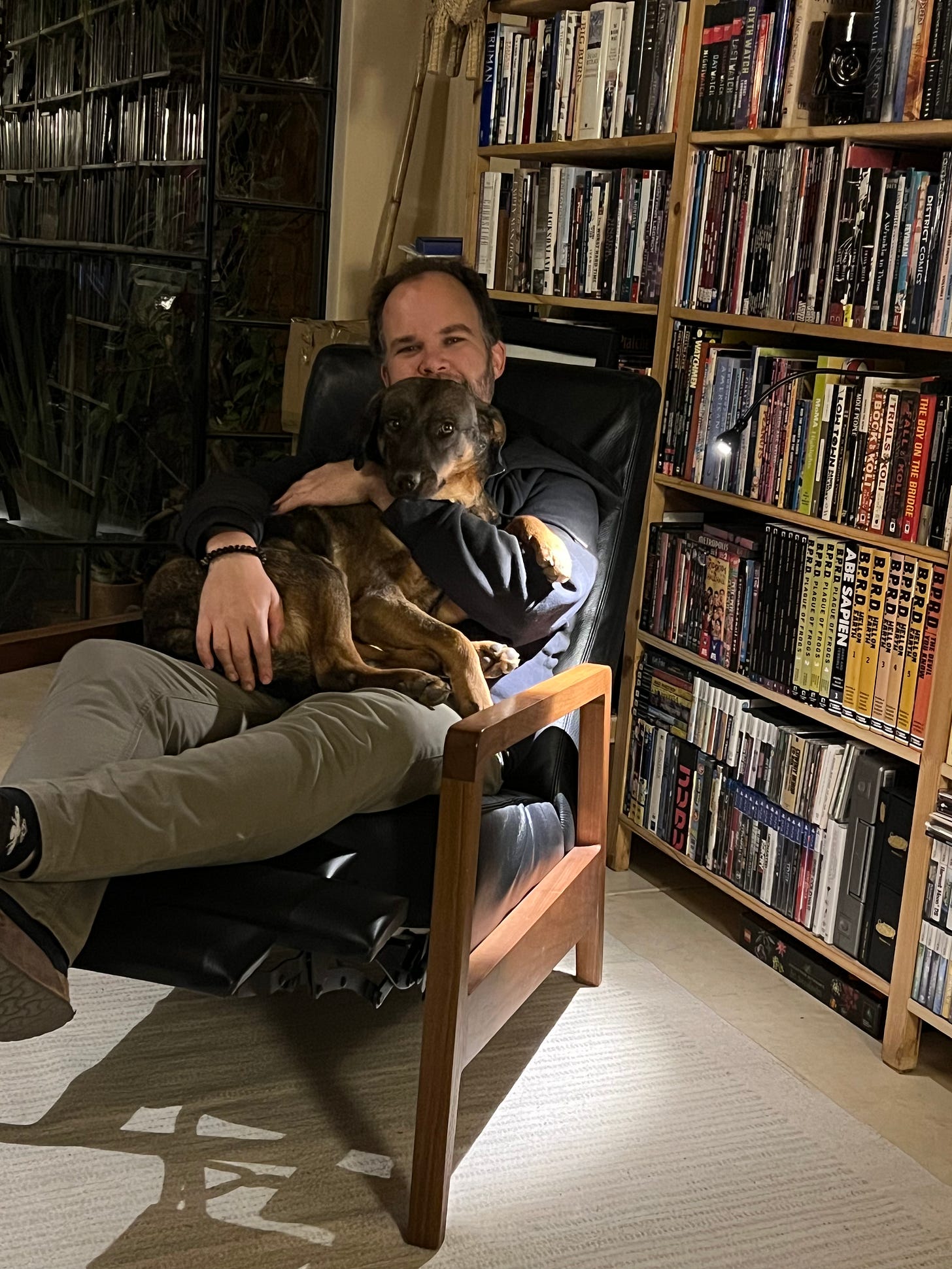Some home improvement have been more complicated than others, and buying furniture hasn’t just been difficult, it’s been almost impossible.
To be sure, Oaxaca does indeed have furniture stores, and it’s not as if we have impossible standards. Like a great many Americans, up until our mid-to-late 30s a huge proportion of our furniture came from IKEA, and the random pieces of furniture we had from other places were exceptions. The defining piece of furniture in our New York City apartment, for example, was an absolutely enormous solid wood dining table with two removable leafs (!), capable of seating 12-to-14 people (!!), I inexplicably purchased at the end of college right before moving to Brooklyn to attend grad school at John Jay. And during the pandemic, after many hours of research, we bought a sofa from a direct-to-consumer company called Interior Define, resulting in our owning a real lemon of a couch from a company that soon after our purchase became known for their shoddy workmanship. But until we finally hit the point we were able to start buying what some might call “real” furniture, around age 38, it was IKEA or sit on the floor.
So, when we moved to Oaxaca we weren’t seeking out luxury furniture. Sure, I’d been haunting the Instagram accounts of any number of furniture designers in both Mexico City and Oaxaca, but it was out of curiosity, not future planning. We save a substantial amount of money by living in Mexico, but it doesn’t really matter if an armoire that would cost twenty thousand dollars in the U.S. only costs 8 thousand dollars in Mexico; we still weren’t going to spend 8 thousand dollars on an armoire.
Searching the internet for furniture stores provided us with very little information. Some stores appeared to be permanently closed, and as is so common here, Google Maps showed businesses that either no longer existed, or simply were not where the map said they would be. We turned to our friends and acquaintances instead, but whenever we asked anyone to recommend a store they effectively threw up their hands and said they had no idea, and then recommended we try Sears or Liverpool, department stores selling American-style furniture that, in true U.S. fashion, was both expensive and of obviously poor quality.
We persisted, but our house continued to sit mostly empty. Our friend Ehren recommended some folks making rustic-style furniture which we thought maybe could work, and despite multiple attempts we were absolutely unable to locate the physical location of their shop. We asked Edgar, who for once was also stumped, and we even asked the guys working on our house, who also had no suggestions. We got so desperate we started to consider buying furniture from the roving carpinteros who sell rough-made pine furniture on various street corners of the city, but the majority of it looked so unfinished and splintery we were never quite able to make the leap.
Eventually we had some limited success when visiting a furniture store called Corazón de Parota, which was recommended to us by our friend Sherie, whose home has some beautiful wood furniture. Corazón de Parota specializes in furniture made with a type of tropical hardwood called huanacastle (also spelled huanacaxtle, and called parota). Huanacastle is beautiful and durable, making it a great choice for furniture, but it’s famous for being challenging to work with because it produces sawdust colloquially called “polvo de chile”—chile dust—which will irritate the skin and lungs.
Unfortunately, and quite strangely, almost all of the furniture being sold by Corazón de Parota was damaged in some minor way. The damage was so consistent across so many pieces of furniture it lead to a somewhat peculiar interaction with the very nice, young salesman who showed us some furniture one evening shortly before the shop we visited was closing.
The location we went to is in Reforma, one of Oaxaca de Juárez’s more modern neighborhoods, and is situated on two floors in a space that is clearly a former warehouse. We wandered up to the second floor to look at dining tables and chairs and after zeroing in on a few we liked we noticed they had some dings and scratches. Given the damage, we asked, would they be willing to lower the price? Or did they have alternatives we could buy that weren’t damaged?
The salesman nicely-but-unapologetically told us, sorry, all furniture is sold as-is and inventory is limited to what we have in stock. We were confused, though, as only minutes before he had showed us a large catalog of furniture and told us we could match different colors and materials with different designs.
“But don’t you make furniture to order if we buy from your catalog,” we asked? “Yes we do!” the young salesman told us.
“So if you make furniture to order, can’t we order some of this model that isn’t dented or scratched?”, we asked. “Sorry,” he replied, “this is all we have in stock.” It was such a strange, circular, nonsensical component of an otherwise easy interaction that we essentially just gave up and allowed him to sidestep our question, choosing to buy some furniture we were happy with. But it stuck in our minds, and a future visit to the shop to look at bed frames made us realize the furniture was too expensive to not be in 100% new condition. We needed an alternative.
Our solution came in the form of a recommendation from Mariana, a woman around our age who works at Maria’s Art y Diseño, a shop in the city located just across the street from Oaxaca’s famed Catedral Metropolitana de Nuestra Señora de la Asunción (Cathedral of Our Lady of the Assumption). We’d been in the shop a number of times to look at their stellar assortment of local art, jewelry, and home goods, and before moving I’d followed them on Instagram. One day immediately after we walked in the woman working behind the counter asked me, “are you Jacob?” She’d noticed I had liked some of their posts and recognized me when we entered the shop, and introduced herself as Mariana.

From then on every time we went into the city we’d make a point to stop by the shop to see if she was there, and during our second or third time talking with her we asked if she had any recommendations for furniture stores.
“Buying furniture in Oaxaca is really hard,” Mariana said. “You can go to Liverpool, which many people think has the best, but it’s expensive.”
We’d tried that already, only to discover the Liverpool furniture was indeed expensive, and also very American, clearly adhering to a bland, beige, contemporary design scheme we weren’t trying to recreate here in Mexico.
“I can also recommend a carpenter,” Mariana said. “He’s a little expensive but his work is very good.”
Edher’s shop, Ensamble Estudio, is in Animas Trujano, a small colonía which lies just east of Oaxaca’s airport. After looking at Edher’s Instagram account I could tell he was a skilled carpenter, but I was particularly interested in seeing a bookshelf he had designed himself, which he called the “Tetris Bookshelf.”
Standing about four feet tall, Edher’s bookshelf was beautiful and sturdy, made from fragments of different types of wood he had around his shop. Simply as a proof-of-quality it was good enough to tell us we could hire him, but as an object in its own right it was intriguing and beautiful, unlike any other furniture we’d seen so far in Oaxaca. It was also, by U.S. standards, not expensive. That day it was Edher’s girlfriend Nathalie minding the shop and I told her how much I’d like to buy the shelf, but that I didn’t have enough cash on me. It wasn’t a problem, and a few days later Edher delivered the furniture to our home with his truck, more than an hour away from his shop.
Soon we found ourselves going to Edher more and more. I purchased two huanacastle-topped side tables for the guest unit’s couch, as well as a couple of cutting boards to give as Christmas gifts to friends and family in the U.S. We hired Edher to make us a television stand, as well as some side tables for one of the guest unit’s beds. And soon enough we were walking him through our house describing in detail the furniture we needed and wanted, as he took careful measurements and showed us pictures of furniture he’d made in the past.
Working with Edher has been an interesting lesson for us. While going to a store in Oaxaca will reward you with immediate gratification, because the selection here can be quite limited you’re very much at the mercy of a shop’s inventory. This is also not a part of the world where you can reliably order things online. A refrigerator we ordered from Liverpool in November still hasn’t arrived even though we’re approaching three months since we purchased it, and a television we bought from Amazon three weeks ago seems to have been stolen in transit, with the Amazon vendor refusing to take responsibility, writing that once it’s shipped, “it’s out of our hands.”
Conversely, working directly with artisans has also proven to be both more reliable and incredibly rewarding. Not only does cutting out the middleman let the artisan make more money (which, in the process, lets you save money), you’re much more likely to get your items in a timely manner, and at a quality you really wouldn’t find in corporate stores.
More importantly though, having someone actually make our furniture feels a bit magical. This type of collaborative purchasing simply doesn’t exist in the United States for people who aren’t wealthy, and that’s especially true when you’re talking about skilled carpentry. There’s no doubting that our own economic position here makes this a particularly workable option, but Edher sets his own prices and we don’t negotiate him down. Despite this, his furniture is both less expensive and of substantially better quality than what we’ve seen for sale in shops.
Edher also is not an exception to the rule. We’ve bought items directly from rug weavers, I had what felt like a momentous visit with an incredibly skilled stone carver (from whom I can only assume we’ll eventually purchase some sort of gigantic, insane carved feature for our home), and we’ve had new cushions custom made for our outdoor chairs and had curtains hand-woven for our home on wooden looms. All of the work was to our specifications, all of it with people we liked, and all of it was more affordable than shopping in a department store or furniture store.
One of the major draws of living in Oaxaca was the proximity to craft and art, but we didn’t realize the degree to which working directly with artisans would be a part of our everyday life. And as people visit and comment on how beautiful the area is, and how comfortable our home is, I can say that it’s not just because we have a good eye for design, or because we had the money to do the work. It’s because of the skill of the people who made these things.








Figuring all out is like a Rubik's cube. But once the code is cracked, ojala (as the Maya say). Life is better.